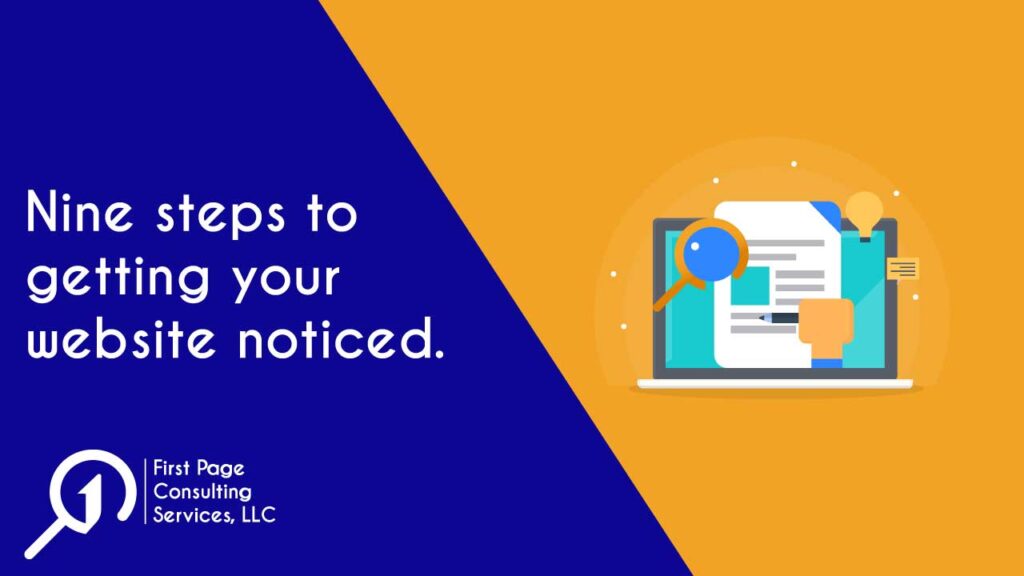
Don't miss another Post. Sign up for our newsletter.
Ten steps to getting your website noticed.
In marketing these days, it seems it’s all about getting noticed. Sometimes, websites remind me of that annoying kid in third grade that always had his or her hand up waving, “pick me, pick me.” Well, that’s not too far the truth with marketing on the web. So, to aid my readers, I’ve come up the nine steps to getting your website noticed, just to help us avoid standing on the desk to get the teachers attention.

Step 1 - Let’s start with the basics.
Tie your laces or you’ll for surely fall down. In your website’s case, it’s selecting the right domain name or web address. Short is better. And catchy. Try to use domain names that only end with .com.
Seriously, who searches for anything with .tv. Also, when you find the perfect address, register the sounds like addresses as well. Just do a search for the multiple spellings of Google. They all go to one place. Avoid using keywords in your web address. Google can penalize a website for using too many keywords. Let’s not start with the web address.
Choose what’s referred to as a branded domain name, it does not contain a keyword or phrase targeted in the search engines. Many will tell you to go with a partial or exact match domain, those that use keywords in the domain. That’s risking too much in my book.
To recap what you're looking for in your domain name...
- Short and catchy
- end in .com
- Register the 'sounds like' addresses too
- Avoid Keywords
Step 2 - We have a registered domain or web address
Yippie! Make sure you have a secure domain. By secure, I mean, make sure your address has a https:// vs. a http://. Adding the secure extension means a ton to Google and any other search engine when ranking a website.
Step 3 - We have our domain name
We have our website registered with a secured extension. We are ready to build the site. The next step, whether we are building or managing a site, is to make sure every page is written with a specific target topic and is rich in associated target keywords. It needs to offer value to the reader. This is called relevance. We need to write every page with an aim to make the page relevant to the reader. This helps in our ranking.
Step 4 - Crawlability
We need to recognize the fact that Google, who by the way has about 85% of the search engine market, behaves like a five-year-old. Although Google has sophisticated “bots” which crawl websites, it wants web pages easy to scan and inspect. This is called crawlability.
Step 5 - Show Reader Engagement
We need to show Google that our users are spending time on our web pages and reading our stuff. That our readers are engaged with our site. We need to show that readers are not spending seconds on the site, then bouncing off.
Step 6 - demonstrate Authority
A website needs to see to have content that is credible and has the ability to get organic (not paid advertising) traffic from Google in order to increase its ranking. This is called authority. How do you improve this your wondering? Getting backlinks from unique websites or referring domains. With that said, if you focus on Steps One through Five, Step Six will happen.
Step 7 - Keywords
This seems obvious but have the best keywords. Keyword selection is ongoing process. Taking a conservative approach, use two keywords per page. Definitely use one in the H1 title, and one in the body of page. We have a guide on keyword selection in another blog, so use the keyword hunting blog for more detailed recommendations.
Step 8 - Blog, blog, blog
I got into this business due to my love and fascination of technology, yet I find myself writing a ton. If you’re like me, DEAL WITH IT! One of the best ways to improve your ranking is to blog and guest blog. Writing your thoughts and ideas down is a great way to gain customers, attract websites, and improve your website’s ranking. (Not interested in writing or don’t have time? Let me know, we have someone who may be able to help you with that.)
Step 9 - Evaluate - is your website getting noticed?
After the site is completed and up and running, have it evaluated on a regular basis. It’s amazing the kind of stuff a SEO will find with a site that has been functioning for some time. Broken links, low word count, poor coding to name a few of the items that causes a site to be downgraded. Regular evaluation and maintenance of a site is like seeing a doctor, it makes sense.
Step 10 - Check out the Competition
Wrap up
Some of the top websites, according to Alexa (as of April 2020) are Google, YouTube, Tmall, and Facebook. If you examine these sites, they follow these steps to a “T.” In fact, they are so popular, they are like cornerstones in our world.
However, think back (if you can), there was a time when Google, YouTube, Tmall, and Facebook did not have such a high ranking. Their continuous pursuit of website marketing helped them gain an impressive footing in the web stratosphere. Use these sites as guideposts of what a website should aspire to be.
Not sure you want to worry about all of this? We’re here to help. Setup a free consultation so we can get your website noticed.